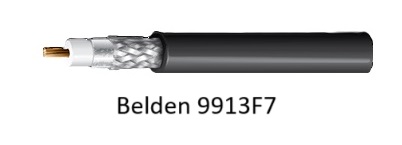No products in the cart.
Exploring Alternatives to LMR-400 Coaxial Cable
Hey folks, welcome to the blog – your hub for all things tech. Today, we’re diving deep into the world of coaxial cables, specifically looking beyond the widely acclaimed LMR-400. If you’re knee-deep in wireless communications or RF applications, stick around because this is about to get interesting.
The Story of LMR-400:
LMR-400 has its own chapter in the book of coaxial cables, celebrated for its low-loss characteristics that make it the go-to for various RF applications. But here’s the kicker – did you know there are other cables out there that could give it a run for its money? Let’s unpack this.
Alternative 1: – The Flexible Contender:
First up in our lineup is the Belden 9913F7. Think of it as the LMR-400’s flexible cousin. This coaxial cable not only bends but also flexes its muscles in the realm of low-loss performance, making it a top pick for many RF enthusiasts looking for a solid alternative.

Alternative 2: Times Microwave Systems LMR-400 UltraFlex – Flexibility Redefined:
Now, picture this – a more flexible version of the already impressive LMR-400. Enter the Times Microwave Systems LMR-400 UltraFlex. It’s like getting the best of both worlds – maintaining stellar performance while offering increased flexibility. Perfect for those situations where flexibility is not just a preference but a necessity.

Alternative 3: Andrew CNT-400 – The Reliable Choice:
Moving down the list, we have the Andrew CNT-400. Born out of the CommScope legacy, this coaxial cable is a reliable choice for RF applications, standing shoulder to shoulder with the LMR-400 in terms of performance. It’s like the dependable friend you can always count on.
Alternative 4: RG-213 – The Unconventional Contender:
Last but certainly not least is the RG-213. While not an identical twin to the LMR-400, it plays the part of the unconventional contender. With similar characteristics and just a touch more loss, RG-213 might be the wildcard that suits your specific needs.
So, there you have it – a lineup of alternatives that might just make you reconsider your go-to coaxial cable. When you’re deep in the world of RF, every choice matters, and it’s essential to consider factors like attenuation, flexibility, and compatibility with your equipment.
Feel free to explore these alternatives based on your specific requirements. The coaxial cable you choose could be the unsung hero behind seamless RF communications. Until next time, tech enthusiasts – stay curious, stay connected!



 العربية
العربية Français
Français Português
Português گؤنئی آذربایجان
گؤنئی آذربایجان Türkçe
Türkçe Lietuviškai
Lietuviškai Español
Español Русский
Русский